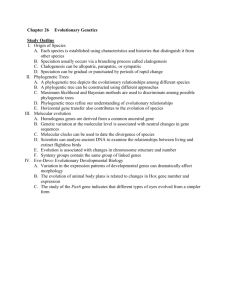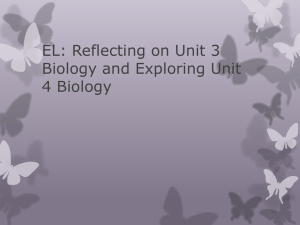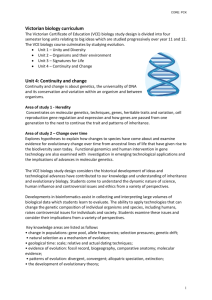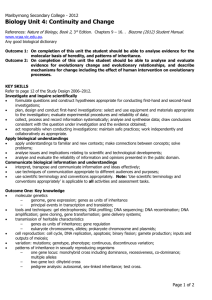Software and Biological Evolution: Some Common Principles
advertisement
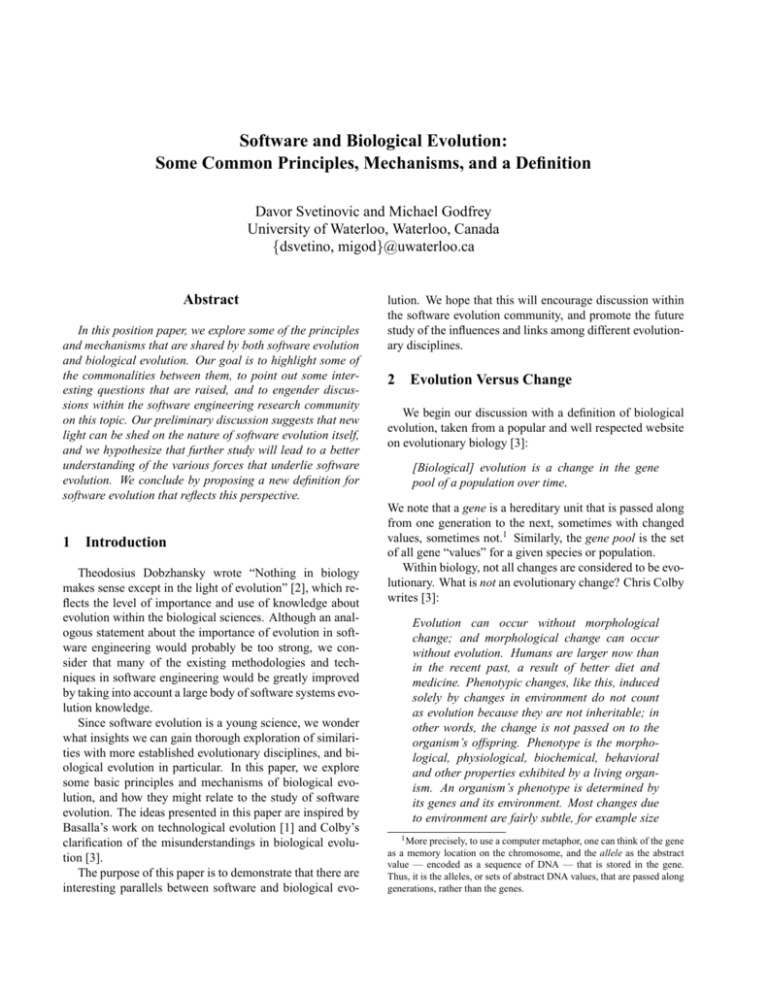
Software and Biological Evolution:
Some Common Principles, Mechanisms, and a Definition
Davor Svetinovic and Michael Godfrey
University of Waterloo, Waterloo, Canada
{dsvetino, migod}@uwaterloo.ca
Abstract
In this position paper, we explore some of the principles
and mechanisms that are shared by both software evolution
and biological evolution. Our goal is to highlight some of
the commonalities between them, to point out some interesting questions that are raised, and to engender discussions within the software engineering research community
on this topic. Our preliminary discussion suggests that new
light can be shed on the nature of software evolution itself,
and we hypothesize that further study will lead to a better
understanding of the various forces that underlie software
evolution. We conclude by proposing a new definition for
software evolution that reflects this perspective.
1
Introduction
Theodosius Dobzhansky wrote “Nothing in biology
makes sense except in the light of evolution” [2], which reflects the level of importance and use of knowledge about
evolution within the biological sciences. Although an analogous statement about the importance of evolution in software engineering would probably be too strong, we consider that many of the existing methodologies and techniques in software engineering would be greatly improved
by taking into account a large body of software systems evolution knowledge.
Since software evolution is a young science, we wonder
what insights we can gain thorough exploration of similarities with more established evolutionary disciplines, and biological evolution in particular. In this paper, we explore
some basic principles and mechanisms of biological evolution, and how they might relate to the study of software
evolution. The ideas presented in this paper are inspired by
Basalla’s work on technological evolution [1] and Colby’s
clarification of the misunderstandings in biological evolution [3].
The purpose of this paper is to demonstrate that there are
interesting parallels between software and biological evo-
lution. We hope that this will encourage discussion within
the software evolution community, and promote the future
study of the influences and links among different evolutionary disciplines.
2
Evolution Versus Change
We begin our discussion with a definition of biological
evolution, taken from a popular and well respected website
on evolutionary biology [3]:
[Biological] evolution is a change in the gene
pool of a population over time.
We note that a gene is a hereditary unit that is passed along
from one generation to the next, sometimes with changed
values, sometimes not.1 Similarly, the gene pool is the set
of all gene “values” for a given species or population.
Within biology, not all changes are considered to be evolutionary. What is not an evolutionary change? Chris Colby
writes [3]:
Evolution can occur without morphological
change; and morphological change can occur
without evolution. Humans are larger now than
in the recent past, a result of better diet and
medicine. Phenotypic changes, like this, induced
solely by changes in environment do not count
as evolution because they are not inheritable; in
other words, the change is not passed on to the
organism’s offspring. Phenotype is the morphological, physiological, biochemical, behavioral
and other properties exhibited by a living organism. An organism’s phenotype is determined by
its genes and its environment. Most changes due
to environment are fairly subtle, for example size
1 More precisely, to use a computer metaphor, one can think of the gene
as a memory location on the chromosome, and the allele as the abstract
value — encoded as a sequence of DNA — that is stored in the gene.
Thus, it is the alleles, or sets of abstract DNA values, that are passed along
generations, rather than the genes.
differences. Large scale phenotypic changes are
obviously due to genetic changes, and therefore
are evolution.
opment of that and similar products and may improve the
processes involved. On the other hand, we believe that detailed studies of evolution in terms of evolutionary changes
would, in addition, contribute to the improvement of software business, software technology forecasting, and so on.
The difficult question is how do we study and classify such
changes, and apply knowledge about them? We will leave
this question unanswered for now. Instead, we now explore
the different mechanisms that work from the basic principles of continuity and diversity to cause evolutionary change
in the software world.
How does this carry to software world? What does constitute an evolutionary change in a software system, and
what is merely a phenotypic change? What is a software
phenotype? How ought we to classify changes in software?
To explore possible answers to these questions, we must
define what a software population is. We believe the
most appropriate and logical parallel between population or
species, in biological terms, and the ones in software terms,
is to consider a species to be analogous to types of software, or software families such as operating systems, compilers, word processors, and so on. This implies in turn
that the notion of an individual living being, in the biological sense, is analogous to the notion of a particular product
in software world (for example, Linux as an operating system, Microsoft Word as a word processor, and so on). If
this were to be true, we might define a true evolutionary
changes as those that occur at the level of a product family,
and affect (more or less) all of its members. We can think
of such changes as essential, since they are incorporated in
all members of the family, while the individuals that do not
incorporate them tend to die out. For example, in the case of
operating systems the appearance of 32 bit processors (and
more recently, 64 bit processors) caused a major evolutionary ripple. Those operating systems that failed to support
the new hardware tended to die out, while most of the survivors successfully provided support for the new hardware.
Another example is support for virtual memory, which allowed operating systems to permit more memory intensive
applications to be active at the same time. The first case
is an example of adaptation in direct response to a change
in the environment — the hardware on which the OS runs
— while the second is an example of an internal change
(caused by design rather than random mutation) that gave a
competitive advantage to those who successfully adopted it.
By extension, phenotypic software changes can be defined as the changes that occur and affect one product
through its lifetime, and do not belong to previously mentioned group of changes. This group consists mostly of
changes that are less crucial to be incorporated into the
product, but give it some competitive edge when compared to the other products from same family. Evolutionary changes consists mostly of changes that must be incorporated into the system in order for the system to stay in
widespread use.
Many phenotypic software changes have been studied,
either directly or indirectly, as part of studies in software
maintenance. These studies give us insight in how a product
changes over time, but usually ignore why and how more
essential changes appear and affect product families. The
results of these studies contribute to the improved devel-
3
Evolution Mechanisms
The essence of evolution is the incorporation of the
variation. As such, whatever mechanisms are causing the
change, they must either increase or decrease the variation
with the population. So, there are mechanisms that (1) increase variation in the population, and (2) mechanisms that
decrease variation in the population.
3.1
Variation Increase
In biological evolution, mechanisms that increase variation are mutation, recombination, and gene flow.
Mutations are caused by mistakes that occur during DNA
replication. The gene sequences are altered by these mistakes, giving the new characteristics to the being that carries
it. These mutations can have positive and negative effects.
Recombination is basically gene shuffling. It occurs during reproduction, when different combinations of alleles are
formed. It occurs both between genes and within a gene. It
contributes to the variation since these new alleles and their
combinations are introduced into the gene pool.
Gene flow is the mechanism that acts in such a way that
genes from one population enter the gene pool of another.
This occurs rarely between distant populations. Also, gene
flow from one part of population to the other, which were
separated for a long time so that changes were incorporated
in both, contribute to the variation since it can produce new
changes.
If we want to make a parallel between these mechanisms
and mechanisms that exist in software evolution, one cannot
help but to remark upon the first difficulty: all three include
reproduction. On the other hand, all possible mechanisms
that introduce variation in the software world are introduced
by intentional human actions. So how do they relate?
We take the stand that it does not matter at all. The important fact is that there exist the mechanisms that introduce
change and variation in both. Who or what is the reason for
this change and variation, and how they get incorporated
into the population is not of great importance. The methodology and consequences stay the same as long as the whole
2
process is the same. Even in the natural world, the reproduction ways are radically different and yet treated the same
from the evolutionary point of view.
Some mechanisms that contribute to variation in software technology include invention, environmental forces,
and product combinations.
Invention leads to variation. Some of the factors that
lead humans to invent are psychological factors, intellectual
factors, social and cultural factors, and economic factors.
These are the general forces that drive invention [1]. There
are numerous cases in software world where this is obvious.
For example, the vision of a computer on every desktop,
dreams about worlds where robots perform most manual
tasks for humans, and so on. Although scientific knowledge
was not of great importance for some types of technologies
(technology is older than science [1]), in software it plays
the primary role. The appearance of software technology is
due to advances in scientific knowledge, which is also the
factor that makes all improvements and innovations possible. It is therefore important to note the correlation between
evolution in science with the evolution of software. Another
example, if we study the evolution of computer viruses as
a kind of software, we discover different social and cultural
issues that have contributed to their appearance and spreading. It is one of the instances where relatively unsophisticated pieces of technology have appeared in socially unacceptable groups and affected the rest of society; viruses
have brought out some negative sides of computer technology, provoking revolt in the other social groups. The open
source software development community is still another example where social and cultural phenomena have played a
major role in the evolution of software systems [4].
Environmental factors are driven by the hardware technology used to support software. There are many ways in
which this influences software evolution. For example, the
emergence of the emulators as a software family has been
directly driven by hardware technology. The difference in
an operating system that is ported to a variety of platforms
is another example. Also, advances in hardware technology allow for new ideas to be applied; for example, faster
processors and cheaper memory have catalyzed research in
model checking and intelligent search engines.
Product combination is a force that introduces variation.
For example, integration of word processors, spreadsheets,
and so on, into the office suites, has invoked the appearance
of the software used for these product bindings, collaborations, and synchronization. Also, the evolution of the web
browsers to application platforms through open formats, interfaces, and plugin architectures. This is the way that more
complex systems are built from less complex ones.
If one wants to make the parallel between biological and
software evolution, one could argue about the similarity of
mutation to the incorporation of new relatively original fea-
tures into the product. Recombination could be treated similar to the product combinations and gene flow could be compared to the improvements due to the flow of knowledge or
similar.
3.2
Variation Decrease
The second group of evolution mechanisms, in biological evolution, consists of natural selection and genetic drift.
Natural selection is the difference in reproductive capability. Some populations reproduce and evolve much faster
than others. There are different positive and negative factors that contribute to this. What is common to all of them
is the requirement for them to act is diversity in the population. Natural selection acts on an individual level; that
is, individuals are somehow selected, and their genes propagate into the next generations of the population. There are
different kinds of natural selection, such as sexual selection,
environmental selection, and so on. The important fact to
remark is that natural selection may not lead toward “improvements” in the population; it works in order to improve
the population in the short term and not in the long term;
that is, natural selection is effectively a greedy algorithm.
Since the short-term conditions may be “false” ones (i.e.,
local greedy optimization or short-lived ones), the population can be badly adapted to what comes in the future. There
is also the misconception that natural selection “pushes” the
population into some more adapted state, but this is not true
since selection operates only on the variation produced by
mechanisms that we mentioned earlier.
Genetic drift is the change in the frequency of alleles in
the population. Usually these changes are due to chance.
Also, fast drops in the population size contribute to the genetic drift.
So, both natural selection and genetic drift decrease the
variation in the population. The basic mechanism is evident; some mechanisms introduce variation and others select which variations will propagate and become a representative characteristic of that population. Since most of these
variations and selection forces are random, it is not possible to expect that the population is moving towards some
utopian ideal. The best chance for a population to improve
is if there is an unlimited amount of variation supplied, and
mechanisms that act upon that variation are severe and of
the same kind that will be present in the future.
In the software world, there are many factors that selectively act upon variation. Some examples are economic
factors, military factors, social and cultural factors, environmental forces, and internal forces.
Economic factors also act indirectly as a selection force.
There are a number of cases when financial support was of
critical importance for the future of some newly discovered
technology. Marketing is also one aspect that contributes to
3
References
the propagation of some kind of novelty.
Although military factors are not usually of great importance for most software technology today, they were the
primary ones responsible for its selection at the beginning
of the software industry. For example, the Internet itself and
many DARPA-sponsored projects fall into this category.
Social and cultural factors are present in almost all selection processes. One example of how the social and cultural factors shape the evolution of technology is the attitude
of followers of open source movement toward commercial
technologies. The non-acceptance from their side of commercial technologies limits the propagation of those technologies and their evolution in these groups.
Environmental forces perform selection both directly and
indirectly. For example, if some software product needs a
lot more processing power than is commonly available, it
will not be used widely, which will directly affect its ability
to spread. In the meantime, another superior technology
may appear and when there is enough of processing power,
the other one will evolve faster and be accepted more widely
than the first one.
As Lehman famously remarked, internal forces are
rooted in the inherent complexity of software development
[5, 6]. These are the forces that can slow down the evolution of a product. Some tasks are very hard to complete, and
products that support them are very complex; this complexity slows down the evolution, and products that are more
manageable are much more likely to evolve.
4
[1] G. Basalla. The Evolution of Technology. Cambridge University Press, 1988.
[2] T. Dobzhansky. Nothing in biology makes sense except in the
light of evolution. The American Biology Teacher, 35:125–
129, 1973.
[3] Introduction to evolutionary biology.
http:
//www.talkorigins.org/faqs/
faq-intro-to-biology.html;
accessed April
25, 2005.
[4] M. W. Godfrey and Q. Tu. Evolution in open source software: A case study. In ICSM ’00: Proceedings of the International Conference on Software Maintenance (ICSM’00), p.
131, Washington, DC, USA, 2000. IEEE Computer Society.
[5] M. M. Lehman and L. A. Belady, editors. Program evolution:
processes of software change. Academic Press Professional,
Inc., San Diego, CA, USA, 1985.
[6] M. M. Lehman, D. E. Perry, and J. F. Ramil. Implications of evolution metrics on software maintenance. In ICSM
’98: Proceedings of the International Conference on Software
Maintenance, p. 208, Washington, DC, USA, 1998. IEEE
Computer Society.
Conclusion and a Definition
In this position paper, we have performed an early exploration and comparison of software and biological evolution. As we have seen, even this early exploration reveals
many similarities from basic principles to underlying mechanisms. This opens up many important questions for future
research. Should we proceed in this direction and work on
the establishment of a more detailed comparison? Could we
transfer some research methods from biological evolution to
software evolution? What are the concrete connections between software and biological evolution — how software
impacts human evolution? All these and many other questions need answers!
To conclude, we would like to propose a new definition
of software evolution that reflects the discussion in this position paper:
Software evolution is change in the essential
properties of a software product family over time.
Our next goal is to explore what, exactly, those essential
properties are.
4
